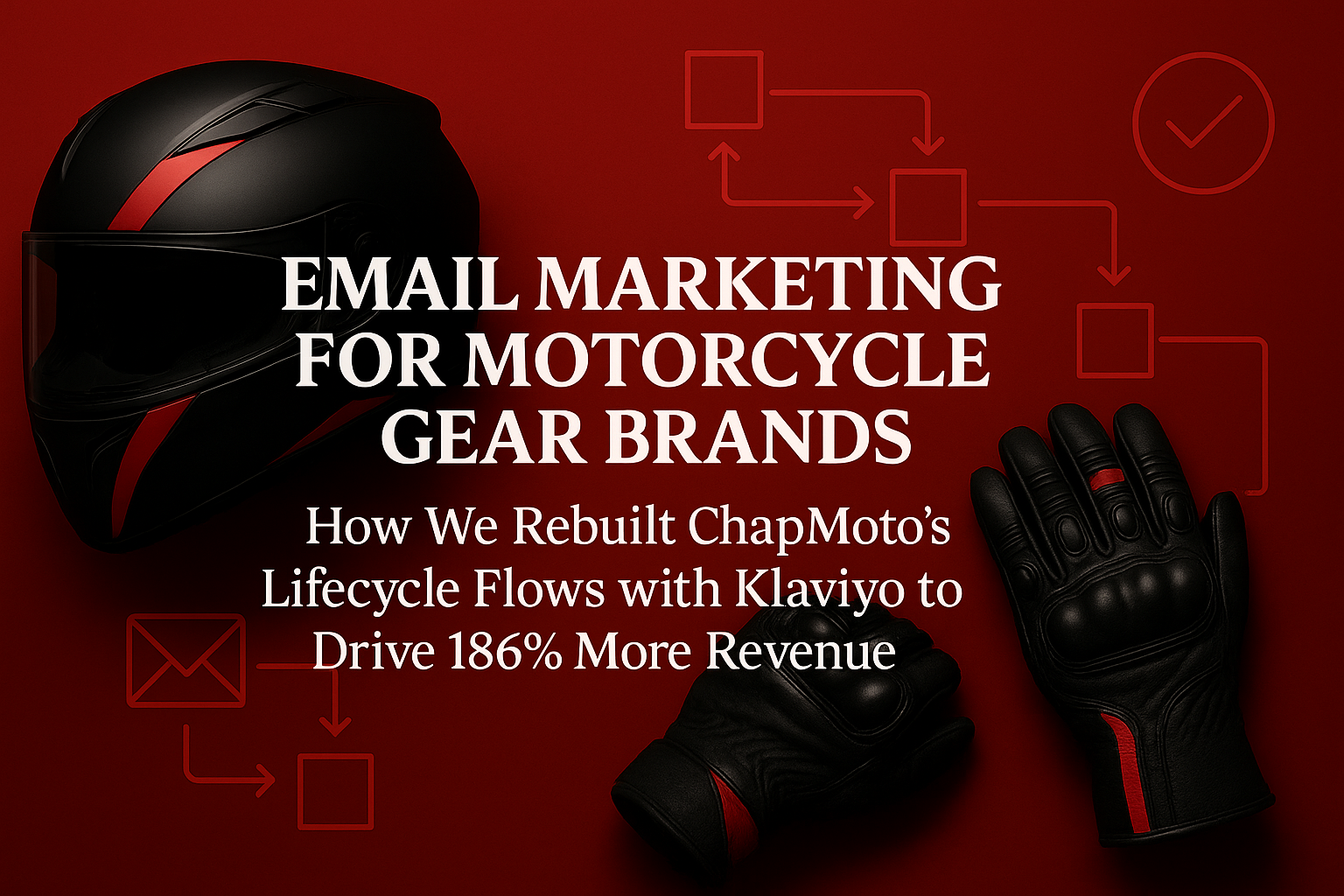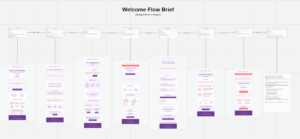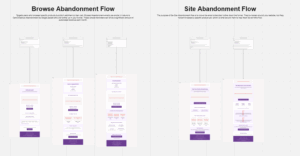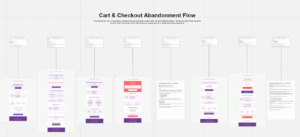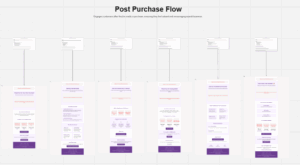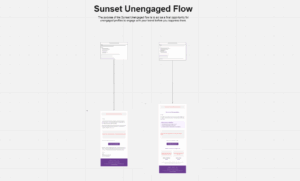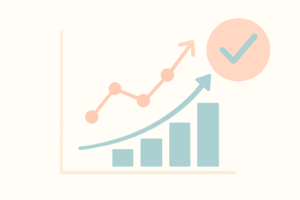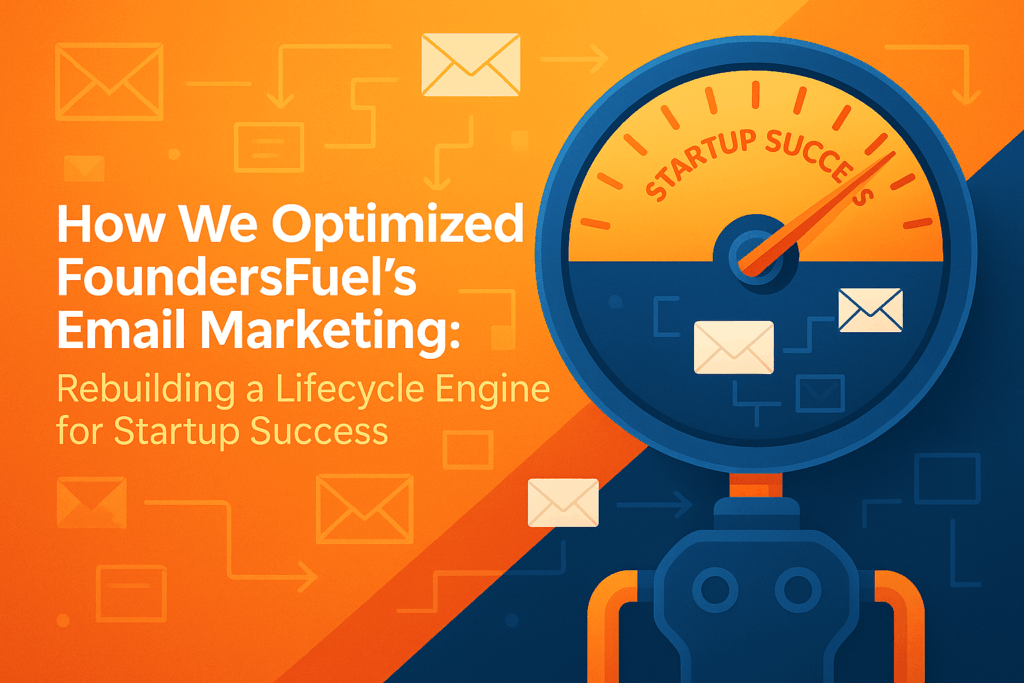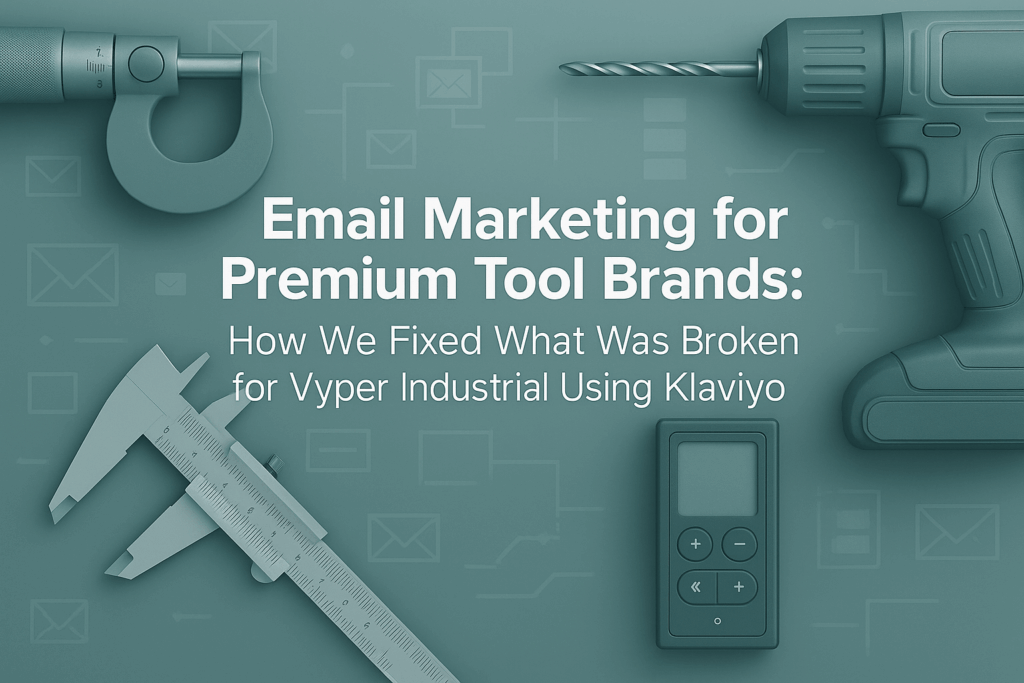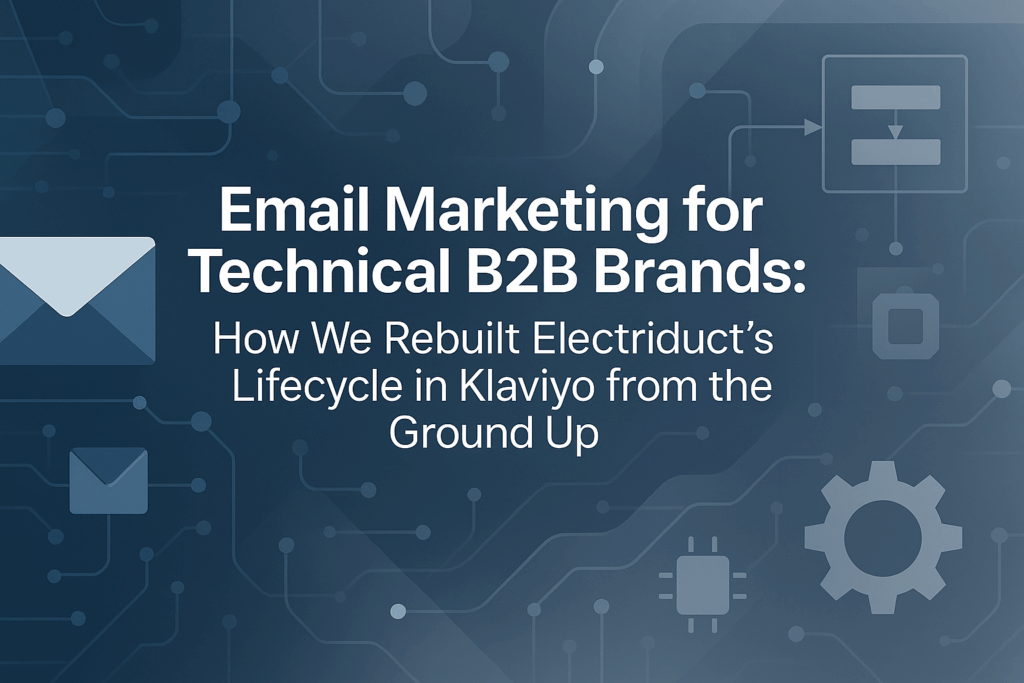In the fast lane of motorcycle parts and gear retail, ChapMoto has long been a trusted name. But even with a loyal following and a deep product catalog, they were facing a familiar friction point: their emails weren’t pulling their weight.
Too many visitors were dropping off. Too few first-timers were coming back. The flows? Short. Disconnected. Heavy on information, light on persuasion. There was no rhythm, no relationship — just a handful of emails that didn’t reflect the heart of the brand or the needs of its riders.
ChapMoto knew they were leaving revenue on the table. But more than that, they knew they were missing the chance to guide, inspire, and connect with the people who already wanted to hear from them.
That’s where we came in.
We didn’t just patch a few flows. We rebuilt the entire email experience — strategically, sequentially, and with the mindset of a brand that wants to ride alongside its customers, not just sell to them. We studied how riders shop, where they hesitate, and what helps them choose. Then we built a 34-email system designed to meet them at every turn — from first welcome to long-term loyalty.
Welcome Flow Optimization: Making First Impressions Count
A welcome flow isn’t just a formality. It’s the digital equivalent of someone walking into your garage, pulling up a stool, and asking, “So, what do you ride?” It’s your chance to build a real connection from the very first click.
When ChapMoto brought us in, their original welcome sequence was technically “there” — but it didn’t feel like them. It was short. Generic. It delivered a discount code and moved on. But this is a brand with legacy, depth, and real loyalty in the riding world. Their welcome flow didn’t sound like a crew that builds gear for people who live on two wheels. And it wasn’t converting the way it could.
So we rebuilt it — not as a sales funnel, but as a relationship builder.
We expanded it to 8 purpose-driven emails, spaced across two weeks. Each message had a clear job to do, whether that was delivering value, building trust, or simply helping a rider find their bearings. Here’s what that journey looked like:
1. Introduction and Discount Delivery
We kept it simple, respectful, and useful. A warm “welcome to the garage” tone. A clean, mobile-friendly layout. And a clear, 15% discount code delivered with zero gimmicks.
We didn’t shout. We introduced. We paired a hero image with some of ChapMoto’s most loved gear and let the brand voice do the work: confident, laid-back, and undeniably made for riders.
This email got a 58% open rate and a 24% click-through rate — a signal that the right tone and right timing still matter.
2. Brand Story and Mission
This was about making the brand feel human. We pulled in a founder story — not some corporate bio, but the reason ChapMoto exists in the first place. We talked about passion for the ride, not revenue. The photos showed people who ride. The words told a story worth believing in.
3. Bestseller Showcase
Now that trust was starting to take shape, we showed them what real riders love most. But we didn’t just list bestsellers — we explained why they’re trusted. What makes a certain helmet a go-to. How a jacket holds up in the rain. Where the performance meets the road. It felt like asking a buddy, “Hey, what gear do you actually use?”
4. Discount Reminder with Urgency
We didn’t lean on scarcity panic. We just gave a gentle nudge — “Hey, your 15% off is about to expire.” Paired with some smart product suggestions based on what they browsed, and a clear CTA. Urgency, yes — but without the pressure.
5. Brand Differentiation
This was a quiet mic drop. Not chest-pounding, just a clear comparison of why ChapMoto does things differently. Free returns. Fast shipping. Real rider service. A few simple icons. A short story. And a visual layout that said, “We’ve got you.”
6. Social Proof Showcase
Instead of telling them to trust ChapMoto, we showed them why others already do. Real customer photos. Short testimonials. An average 4.7-star product rating across the site. Not overproduced. Not oversold. Just voices that sound like the person reading it.
7. Final Discount Reminder
At this point, if they hadn’t purchased, we gave them one last reminder — no tricks, just a final heads-up that their offer was expiring. A single bold button. No distractions. No new pitches. Just clarity.
8. Personal Note from the Founder
We ended with a real note from Mike — the kind you’d send to a friend who hadn’t gotten back to you. No template. No graphics. Just a plain-text message that asked, “Anything holding you back from getting started?” It closed the loop with honesty, not a hard sell.
Why This Flow Worked
This wasn’t just a new welcome flow — it was a new first impression. One that sounded like ChapMoto. Looked like ChapMoto. And helped riders feel like they’d found their new go-to shop.
Abandonment Flows: Bringing Riders Back Without the Push
Most brands treat abandonment emails like alarms: “Hurry back!” “Don’t miss out!” But that’s not how real riders think — especially when they’re trying to find gear they can trust.
ChapMoto’s customers weren’t walking away because they weren’t interested. They were comparing fit. Thinking through options. Wondering how that helmet would feel on a six-hour ride. So instead of hard-selling, we leaned into clarity and confidence.
We rebuilt each abandonment sequence to answer unspoken questions and make re-engagement feel less like pressure — and more like a helpful riding buddy saying, “Hey, need another look?”
Site Abandonment Flow (2 Emails)
These were for riders who browsed a few categories, maybe clicked around — but didn’t get too deep.
1. Still Browsing? Here’s What Riders Love
We resurfaced the exact categories they viewed — boots, jackets, helmets — and paired them with top-rated picks. Not just “shop now,” but “here’s what other riders love and why.” No fluff, no push.
2. Choosing the Right Gear for Your Ride
This was education over persuasion. If they were looking at touring gear, we sent a quick-fit guide and long-ride durability tips. If they were eyeing dirt helmets, we shared insights on airflow, padding, and peak design. The tone? “Let’s help you find the right fit for your ride.”
This flow wasn’t built to close. It was built to support the kind of decision that deserves a second look.
Browse Abandonment Flow (3 Emails)
When someone takes time to view a specific product, but doesn’t move forward, that’s not disinterest. That’s hesitation. So instead of pushing harder, we leaned in softer. These emails weren’t about closing a sale. They were about clearing the fog.
1. Why Riders Love What You Looked At
If someone spent time on the Arai XD-4 page, we didn’t send a generic follow-up. We brought the helmet to life through the lens of real-world use — the true dual-sport versatility, a ventilation system that holds up when the ride gets intense, and durability that doesn’t flinch off-road. For the TCX Street 3s, we highlighted the kind of details that matter when you’re actually walking in them — cushioned comfort, solid ankle protection, waterproof ease. And we didn’t use product blurbs. We used a rider’s own words — a short quote that felt like it came straight from the trail, because it did. That’s what built trust.
2. Complete the Setup
Instead of shouting “You forgot something,” we reframed the moment: “Want to round this out?” A helmet came with the right visor recommendations. Boots got paired with armored socks or waterproof sprays. This wasn’t upsell territory — it was preparation. The kind that makes a ride smoother, safer, more complete. Every accessory we featured had a job to do, and we made sure it was clear what that job was.
3. Still Thinking? No Rush
The final email in the flow didn’t push. It reassured. “We get it — gear matters, and you want to choose right.” We let them know the product was still available, and paired that with a few quiet words from riders who’d been in the same spot — curious, cautious, wanting to be sure. No countdown clocks. No urgency language. Just confidence, patience, and a little social proof to nudge them forward — only when they were ready.
Why This Flow Worked
Because it respected the rider’s process. Gear like this isn’t bought on impulse. It’s researched. Compared. Slept on. These emails gave riders space to make the right call, with better info, fewer doubts, and just enough assurance to tip the scale.
Cart & Checkout Flow: Helping Riders Cross the Finish Line
Cart abandonment happens for all kinds of reasons — distractions, questions, second-guessing. For a gear-heavy brand like ChapMoto, it’s rarely about price alone. Riders care about fit, compatibility, and confidence in what they’re buying. So we built this 8-email sequence to meet them in that hesitation, not with pushiness, but with clarity, answers, and reminders that felt helpful, not nagging.
1. Your Gear’s Still Here
This was the first reminder — quick, friendly, and friction-free. It showed exactly what was in the cart, highlighted delivery timelines, and reassured riders that their picks were saved and ready when they were.
2. Need Help Deciding?
Next, we stepped in with support, not sales pressure. This email introduced the customer service team (with names and faces), added links to size guides and product FAQs, and made it clear: “If something’s holding you back, we’re here to help.”
3. Here’s Why It’s Worth It
This one zoomed in on the product’s benefits. We turned specs into stories — why that jacket holds up in rain, how those gloves reduce fatigue on long rides. We reminded riders of what drew them in and made sure they knew they were choosing gear built to perform.
4. Hear It From Other Riders
Instead of us saying “this is great,” we let the community do the talking. We featured real testimonials tied to the items in their cart, including review highlights, star ratings, and photos of riders using the gear in the wild.
5. Just a Little Extra
Sometimes, a small gesture tips the scale. This email offered a light incentive — maybe free shipping, maybe a small bonus item — framed as a thank-you, not a discount. The message? We want you riding happily, not rushed.
6. Your Cart’s About to Expire
We introduced a bit of urgency, but kept the tone respectful. “Heads up — your gear might not be here much longer.” Inventory reminders and gentle nudges helped move riders who were on the fence without making them feel pressured.
7. One-Time Offer
At this point, we offered a stronger incentive — but only if it felt earned. A personalized offer, based on cart value or product category, showed we were paying attention. It wasn’t a blanket discount. It was a thoughtful push.
8. Last Call
This was the closer — simple, clear, and final. One last reminder with their cart contents and a single call-to-action. No urgency hype. Just a quiet tap on the shoulder: “If you’re ready, we’re here.”
Why This Flow Worked
Because it respected the rider. We didn’t assume they’d forgotten. We assumed they were still deciding. By answering their questions, reminding them of what mattered, and showing that we understood their hesitation, we turned unfinished carts into finished orders — not through pressure, but through presence.
Customer Retention Flows: Loyalty Built on Value, Not Just Discounts
Retention isn’t about keeping customers on a drip campaign. It’s about showing up after the sale in ways that still feel useful — like you understand what kind of ride they’re on and what support looks like once they’ve hit the road.
We rebuilt three flows that moved in sync with the customer lifecycle — each one designed to extend the experience, not just extend a sales pitch.
Post-Purchase Flow: What Happens After the Checkout
The moment someone places an order isn’t the end — it’s the beginning of everything that matters. This 6-part sequence was built to turn anticipation into trust, and first-time buyers into long-term riders.
1. Order Confirmation
Not just a receipt. A reassurance. We told them what’s coming, when it’s coming, and how to reach us if something feels off. No generic lines — just clarity and excitement.
2. Shipping Confirmation
As soon as their gear was in motion, we let them know — with tracking info, delivery estimates, and a few pre-arrival tips to help them get the most from the moment it hits their doorstep.
3. Pre-Delivery Education
We don’t assume every customer is a pro. This email offered quick-read care tips, setup advice, and sizing tricks — so that when the box shows up, they’re not wondering what’s next.
4. Gear Check-In
A day after the expected delivery, we followed up: “How’s it fitting? Anything feel off?” It included direct links to leave a review, ask a question, or browse accessories that paired well with their order.
5. Product Tips
After a week, we shared a short guide specific to their product type — helmet care tips, boot break-in hacks, or armor fit suggestions. No upsell, just actual use-case value.
6. Build the Rest of the Setup
Two weeks out, we offered curated recommendations. The tone wasn’t “You forgot something” — it was “Want to round this out?” Based on what they bought, we helped them consider the rest of their build.
Why This Flow Works
It didn’t just reduce post-purchase anxiety — it added post-purchase clarity. The more riders understood their gear, the more they trusted the brand behind it. That trust paid off in reviews, referrals, and a higher rate of repeat purchases.
Winback Flow: A Check-In, Not a Chase
Some customers go quiet. That’s normal. But instead of blasting discounts and begging them back, we built a 5-email sequence that started with a simple premise: maybe they just needed to hear from us like a fellow rider, not a brand with a quota.
1. Just Checking In
This wasn’t “We miss your money.” It was, “How’s the gear been treating you?” A friendly note, no push — just a re-opening of the conversation.
2. What’s New in the Garage
We highlighted new arrivals they hadn’t seen: upgraded gear, seasonal drops, or redesigned favorites. But not in a catalog format. We picked items they’d likely care about, based on what they’d bought before.
3. Loyalty Reminder
Sometimes they just forget that they’re earning points, that there’s a loyalty tier with perks, that repeat customers don’t just get thanks — they get gear perks. So we reminded them.
4. A Helpful Hit of Content
This one wasn’t about selling at all. It was pure utility: maintenance checklists, ride prep guides, packing tips for weekend getaways. Because sometimes, the best way to re-engage is to offer something useful with no strings.
5. A Small Nudge
We closed with a soft incentive — nothing flashy. Just a little thank-you in the form of a discount or a freebie, framed as “if now’s the time, we’ve got you.”
Why This Flow Works
We didn’t treat silence as rejection. We treated it like distance. And we responded with respect, not urgency. The tone said, “We’ll be here when you’re ready.” And that tone brought riders back without gimmicks.
Sunset Flow: Respect Before Removal
When someone hasn’t opened a single email in months, most brands push harder. We don’t. We designed a two-part sequence that respected inboxes — and gave people the dignity of choosing.
1. Still Want to Hear from Us?
One clear question. No tricks. No reverse psychology. Just: “Still want to hear from ChapMoto?” with easy buttons to stay or go. That alone brought plenty of disengaged riders back to life.
2. One Last Thing
A final, gentle sendoff. If they didn’t respond, we let them go with a quick summary of what they’d be missing — not in a guilt-trip way, but a “just so you know” tone. Plus options to follow us elsewhere if email wasn’t the right channel.
Why This Flow Works
Unsubscribes went down. Re-engagement went up. Because we stopped treating every email as a sale — and started treating it as a relationship. Even good ones need space sometimes.
Strategy & Implementation: Turning Flows Into an Ecosystem
This wasn’t a checklist of flows. It was a system designed to move with the rider. We built a communication layer that mirrored real behavior, responded in real time, and created momentum — not noise.
Flows That Mirror the Road Ahead
We didn’t guess what riders wanted — we watched what they actually did. Someone just starting out got a little extra context. Someone coming back got a nod, not a rerun. And someone who hadn’t engaged in a while got something softer, more human. These flows didn’t chase conversion; they met people where they were.
A Brand That Feels Like the Ride
We made sure every message felt like it came from the same place — a company that gets what it means to ride. Not just in the colors or the logo, but in the way it spoke. Bold, clear, no fluff. Less about specs, more about what it feels like to use the gear. That kind of consistency builds quiet trust.
Messaging That Moves in Sync
Most brands send emails like they’re firing from a cannon — one flow doesn’t know the other exists. We didn’t do that. If someone finished checkout, they didn’t get another cart nudge. If they showed interest post-purchase, we welcomed them in deeper. It all moved together. Clean. In sync.
Personalization That Actually Matters
We didn’t personalize with tokens — we did it with awareness. A touring rider got different gear than someone building a café racer. Mobile visitors got emails that actually worked on mobile. We paid attention to patterns, not just names. It felt like someone on the other side was thinking.
A System That Learns as It Goes
We didn’t walk away after launch. We kept tuning. New seasons, new products, new behaviors — we adapted. Feedback from support calls turned into clearer messaging. And every small improvement made the system more helpful, more human, more worth opening.
Expected Results: What This System Was Built to Deliver
From the start, this wasn’t about sending prettier emails. It was about building a system that actually moved the needle, not just in metrics, but in meaning.
Here’s what the ChapMoto email overhaul was engineered to achieve:
1. 42% Projected Increase in First-Purchase Conversion
Because we didn’t just drop in a discount code and hope for the best. We walked riders through the “why” behind the gear, what made it matter, and how to choose with confidence. The result? Less hesitation. More action.
2. 29.7% Recovery Rate for Abandoned Carts (Up from 12.8%)
The cart flow didn’t guilt or pressure. It reminded people what they liked — and why they liked it. It put the spotlight back on the product’s value and made returning to checkout feel like picking up where they left off, not starting over.
3. 68% Increase in Post-Purchase Repeat Order Rate
Because we didn’t ghost after the first sale. Instead, we sent tips, setup guides, and gear pairings that actually made their ride better. It felt like the brand stuck around — not to push, but to help.
4. 186% Increase in Email-Attributed Revenue
That wasn’t the headline we aimed for, but it happened. When the timing, message, and tone align — and you respect the rider’s journey — the revenue tends to follow.
5. 157% Increase in Revenue per Email Subscriber
Not by chasing volume. By making each email matter. We gave returning customers smarter content, more relevant recommendations, and less clutter — and they responded.
And beyond the data, something else showed up.
Riders started replying. Sharing emails with their crew. Mentioning the post-purchase experience in their reviews. Reaching out to say, “Thanks — this actually helped.”
That’s when you know the system isn’t just working. It’s resonating.
Built to Ride, Built to Last
If you’re still sending generic emails and hoping they convert, it’s time to ask more from your strategy — and your inbox. This isn’t about automation. It’s about connection. About building flows that earn trust, deliver real value, and move your customer from curiosity to confidence.
That’s what we built for ChapMoto. And if you’re ready to build the same — we’re ready when you are.
Let’s contact and create something that actually moves people.



